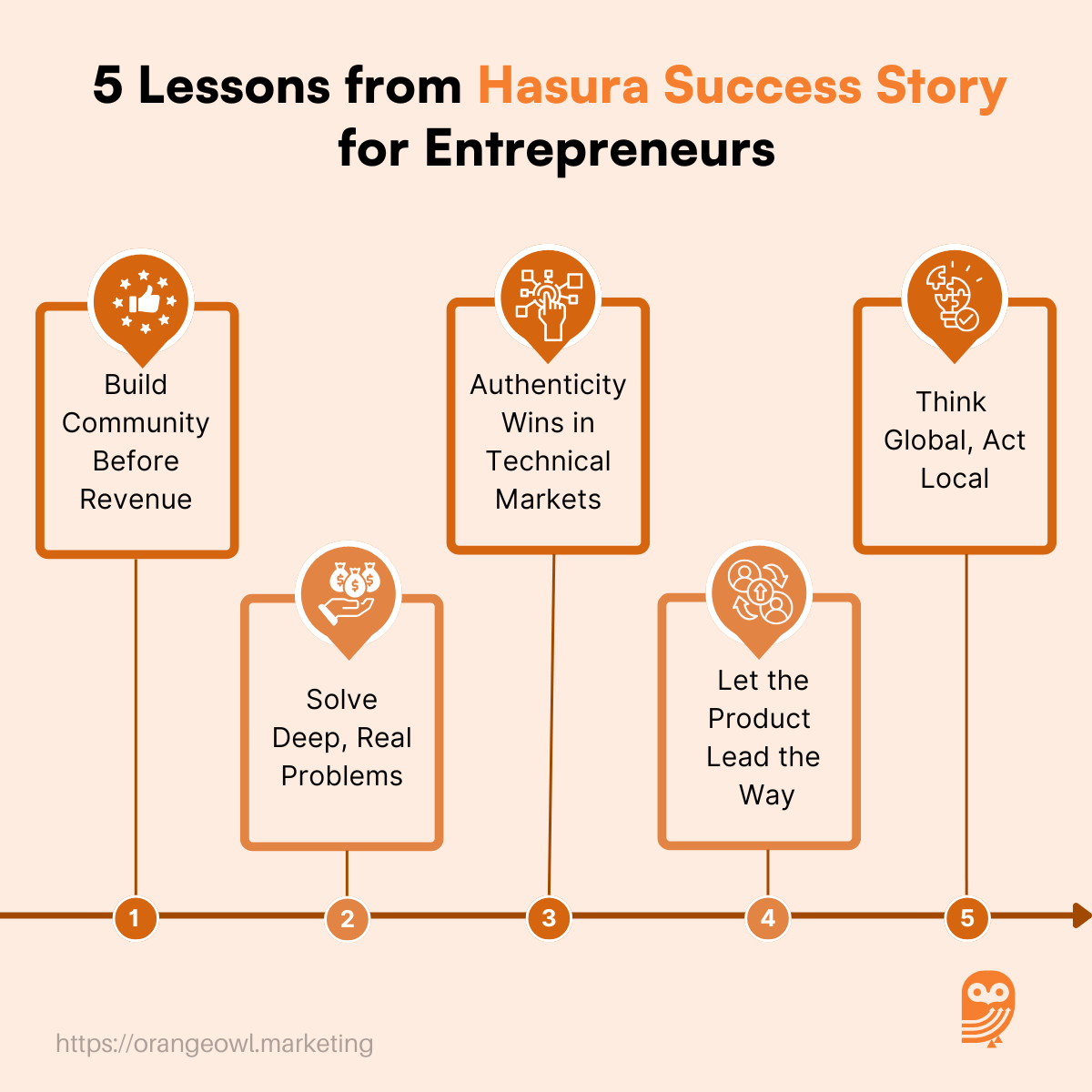Hasura Success Story: 5 Fundamental Lessons for Every Entrepreneur
Vivek Goel
April 29, 2025

Table of Contents
Introduction
In today’s fast-paced digital world, application development speed is everything—and Hasura has emerged as a pivotal player in this transformation. Founded in 2017 by Tanmai Gopal and Rajoshi Ghosh, Hasura offers a real-time GraphQL engine that radically simplifies backend development by instantly generating APIs from databases. As of 2024, Hasura’s GraphQL engine has been downloaded over 500 million times globally and the company works with industry leaders like Airbus, Atlassian, Swiggy, and Netlify.
Backed by marquee investors such as Lightspeed Venture Partners, Vertex Ventures, and Greenoaks Capital, Hasura has raised over $136.5 million in funding (Crunchbase source) and continues to grow its community-driven adoption worldwide. Headquartered in San Francisco with deep engineering roots in Bengaluru, India, Hasura proves that solving a deeply technical and universal developer pain point can unlock massive global opportunities.
“We wanted developers to spend time building value, not plumbing.” — Tanmai Gopal, Co-founder & CEO, Hasura
Origin Story
The idea for Hasura was born out of a deep frustration that Tanmai Gopal experienced firsthand during his time as a software engineer: the massive amount of repetitive, boilerplate work needed to build backend APIs and infrastructure. While working on consulting projects alongside his co-founder, Rajoshi Ghosh, they observed a pattern—companies across industries were spending an outsized portion of their time setting up and managing backend systems instead of focusing on real innovation.
“The idea wasn’t just to automate one piece of the backend, but to rethink how developers interact with data entirely.” — Tanmai Gopal
Initially, the duo started by creating internal developer tools to streamline their own consulting projects in India. However, it quickly became clear that the problem they were solving wasn’t just local—it was a global, fundamental bottleneck in modern software development. In 2018, Hasura made a pivotal move: they pivoted to launch their open-source GraphQL engine. This engine enabled developers to instantly generate secure, high-performance APIs from existing databases without the heavy lifting of writing repetitive code.
Open-sourcing the GraphQL engine turned out to be a game-changing strategy. It sparked massive grassroots adoption among developer communities around the world. Within months, Hasura was gaining global traction, supported by a passionate community that appreciated the speed, flexibility, and real-world problem-solving capabilities the platform offered.
Business Landscape and Early Challenges
Breaking into the highly technical and fiercely skeptical developer tools and API management market was never going to be easy. Developers, known for their critical eye, value authenticity, performance, and real problem-solving over flashy marketing. Hasura understood that it couldn’t “sell” its way into the market—it had to earn its credibility through product excellence and genuine developer trust.
“We had to earn trust one developer at a time. The tech community is brutally honest—you can’t fake it.” — Rajoshi Ghosh
One of the biggest challenges was navigating the tension between open-source adoption and building a sustainable business model. Monetizing an open-source project without alienating the community is notoriously difficult. Hasura tackled this challenge by introducing enterprise-grade features—such as enhanced security, scaling capabilities, and compliance tools—while keeping the core product free and open.
Additionally, building an early user base required relentless focus on developer experience. Every decision—from documentation to onboarding flows—was optimized to minimize friction and maximize value for developers. This attention to user needs, combined with a commitment to authenticity, helped Hasura transform from a small startup into a respected name in the global developer ecosystem.
Growth Strategies
Several strategic decisions fueled Hasura’s impressive growth trajectory in the hyper-competitive world of developer tools. Right from the beginning, Hasura doubled down on open-source, recognizing that empowering developers directly would create an organic distribution engine far more powerful than traditional sales pipelines. By making their core GraphQL engine freely available, Hasura enabled developers to experiment, build, and advocate for the tool within their own organizations. Side projects turned into internal proofs of concept, eventually scaling into enterprise-wide implementations.
Secondly, Hasura embraced a bottoms-up enterprise sales model. Instead of chasing large corporate clients through top-down executive deals from day one, they nurtured grassroots developer adoption. Small wins, fueled by genuine love for the product, often snowballed into inbound interest from IT leadership and procurement teams, leading to broader enterprise contracts.
“We didn’t start with top-down selling. We started by building something that developers loved.” — Tanmai Gopal
Beyond community building, Hasura strategically established a strong presence at global developer conferences like GraphQLConf and collaborated with industry giants such as Microsoft and AWS. These partnerships helped extend Hasura’s credibility and reach within technical circles. Furthermore, strategic funding rounds—such as their Series A ($9.9 million) and Series B ($25 million)—allowed Hasura to invest heavily in R&D and community initiatives, rather than being forced into aggressive commercialization too early. This long-term view of value creation over immediate monetization kept the developer community’s trust intact and set the stage for sustainable scaling.
Marketing Strategies
Hasura’s marketing strategy was developer-first: rather than traditional advertising, they focused on education, enablement, and empowerment. The cornerstone of their approach was to make learning and using Hasura frictionless. This included investing heavily in open documentation, live coding tutorials, hackathons, webinars, and community-driven meetups. Their materials were tailored for real-world use cases, helping developers see tangible results fast.
Another pillar of Hasura’s growth was its commitment to product-led growth. The team knew that if they could deliver a stellar developer experience, users would naturally become advocates. Every aspect of the onboarding journey was designed to be smooth, intuitive, and value-driven. Developers who enjoyed the “Aha!” moment of rapidly building powerful applications with Hasura became the company’s strongest marketing assets through word-of-mouth and community endorsements.
“Our best marketing has been our product—and the love developers show when it makes their lives easier.” — Rajoshi Ghosh
Moreover, Hasura amplified its credibility by publishing case studies that demonstrated how enterprises dramatically accelerated time-to-market and reduced engineering complexity by integrating Hasura. These real-world success stories offered social proof and built confidence among technical decision-makers.
By staying true to the needs of the technical community, investing in education, and maintaining a laser-sharp focus on product excellence, Hasura built a powerful brand—one that is now synonymous with speed, reliability, and innovation within the GraphQL and modern app development ecosystems.
5 Lessons Every Entrepreneur Should Learn from Hasura
1. Build Community Before Revenue
Hasura’s success shows that building a strong community can precede—and even fuel—monetization. By focusing first on open-source adoption rather than chasing revenue, Hasura cultivated a loyal developer base that organically evangelized the product. This early community not only drove initial traction but also provided invaluable feedback that sharpened the product-market fit. Entrepreneurs should recognize that investing in user love and loyalty early often creates a natural growth flywheel, making revenue generation smoother and more sustainable later.
2. Solve Deep, Real Problems
Rather than chasing trends or superficial market needs, Hasura tackled a critical, everyday pain point: the repetitive, time-consuming nature of backend API development. Developers everywhere struggled with this problem but had accepted it as a necessary burden—until Hasura reimagined a solution. By solving a deep, frequently encountered problem, they made themselves indispensable to the workflow of modern app builders. Entrepreneurs should aim to identify and solve “toothache” problems—issues that are painful enough that users actively seek a remedy.

3. Authenticity Wins in Technical Markets
In sectors like developer tools and infrastructure, technical audiences are brutally honest—they can spot hype from a mile away. Hasura’s approach was built on authenticity, transparency, and technical excellence, not flashy marketing promises. They let the product’s real capabilities do the talking, earning trust through open-source contributions, clear documentation, and continuous improvement based on community input. Entrepreneurs entering technical or skeptical markets must understand: authenticity isn’t a choice—it’s the price of admission.
4. Let the Product Lead the Way
Instead of investing heavily in traditional sales and marketing channels early on, Hasura prioritized crafting an exceptional product experience. Their strategy was simple: make developers’ lives easier and better, and they will naturally become advocates. This product-led growth strategy allowed them to expand inside organizations organically, from a handful of developers experimenting with Hasura to company-wide adoption. Entrepreneurs should learn that sometimes the best marketing investment is simply making a product so good that users can’t help but recommend it.
5. Think Global, Act Local
Although rooted in India, Hasura always had a global vision from day one. They understood that developer problems are universal and that innovation shouldn’t be confined by geography. By open-sourcing early, engaging international tech communities, and understanding global developer expectations, Hasura positioned itself as a truly global company. Entrepreneurs everywhere should internalize this mindset: where you are located is less important than where your vision and impact can reach. In a connected world, thinking global from the start is not optional—it’s strategic.
Conclusion: Key Takeaways from Hasura’s Journey
Hasura’s journey is a masterclass in focused innovation, authentic leadership, and community-first growth. Starting with a simple but profound observation—that backend development was unnecessarily complex—Tanmai Gopal and Rajoshi Ghosh built a company that didn’t just offer another tool, but fundamentally changed how developers interact with data.
In the highly technical world of developer platforms, credibility must be earned through product excellence and genuine engagement. Hasura understood this from the start, choosing to win trust one developer at a time rather than chasing flashy marketing or quick wins. That commitment to authenticity fueled grassroots adoption, enterprise expansion, and global recognition.
For entrepreneurs, Hasura’s story is a powerful reminder:
Start with a real, painful problem that users are desperate to solve.
Prioritize building a community over chasing revenue in the early days.
Stay authentic and transparent, especially when serving technical audiences.
Let your product be your loudest marketing voice.
Think globally from the start, without being constrained by location or resources.
As the world races deeper into a digital-first era, the need for speed, flexibility, and developer empowerment—principles Hasura champions—will only become more critical. Hasura’s rise isn’t just a story about a great product; it’s a blueprint for building companies that endure by staying true to their mission and their users.


